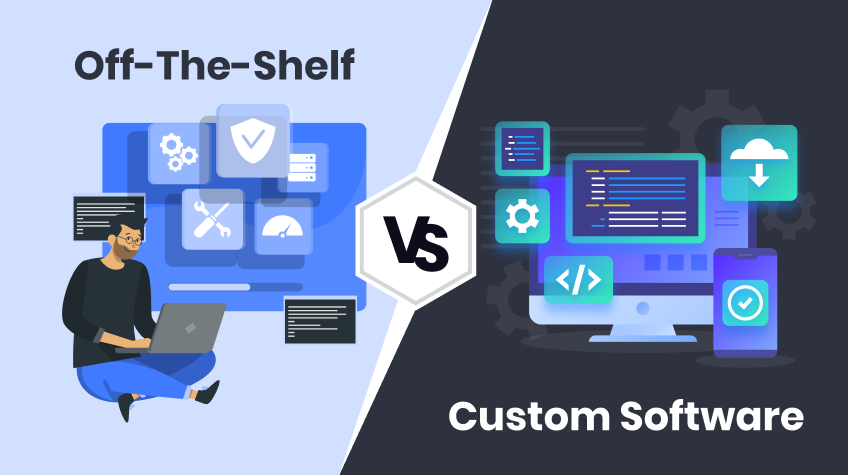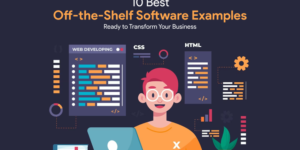
Introduction
In the dynamic landscape of modern business, the pivotal decision between Off-The-Shelf (OTS) software and Custom Software Development (CSD) can define an organization’s trajectory. The dilemma becomes paramount as businesses rely on software solutions for efficiency and innovation.
This comprehensive guide aims to navigate this choice, highlighting the nuances of off-the-shelf and custom solutions. With the stakes high and technology evolving rapidly, the right decision hinges on understanding specific business needs, budget considerations, and the scalability required for future growth. Join us on this exploration to make an informed choice for sustained success in the digital era.
Understanding Off-The-Shelf Software
Definition and Characteristics
Pre-packaged software is available for purchase and use without extensive customization. These solutions are mass-market products designed for a wide range of needs. Characteristics include being pre-built and ready-to-use, allowing businesses to implement them with minimal configuration.
Advantages of Off-The-Shelf Software
- Cost-Effective: Generally more affordable than custom solutions due to widespread use and distribution.
- Quick Deployment: Rapid implementation as the software is already developed, reducing time-to-market.
Limitations and Drawbacks
- Limited Customization: Inflexibility to adapt fully to unique business processes and requirements.
- Potential for Feature Bloat: Includes features that may not be relevant to all users, leading to a cluttered interface.
Examples
- Microsoft Office: Widely used for office productivity but might have features unnecessary for specific business operations.
- QuickBooks: Efficient for standard accounting needs but may lack customization for unique financial workflows.
- Salesforce: Powerful for CRM, but businesses may encounter challenges adapting it to highly specialized sales processes.
By understanding these aspects of off-the-shelf software, businesses can weigh the convenience of quick implementation against the potential trade-offs in customization and feature alignment.
Exploring Custom Software Development
Definition and Characteristics
Custom Software Development Involves the creation of unique, tailor-made applications designed to address specific business requirements and challenges. Custom software is crafted to fit the unique requirements of businesses, providing a customized solution to meet their needs and objectives. Custom solutions are inherently scalable and capable of growing and evolving alongside the business.
Advantages of Custom Software
- Full Customization: Offers the ability to tailor every aspect to meet the specific needs and processes of the business.
- Scalability: Custom software can scale seamlessly as the business grows and faces new challenges.
Challenges and Considerations
- Higher Initial Cost: Custom development often requires a larger upfront investment than off-the-shelf solutions.
- Longer Development Time: The development process for custom software can be more time-consuming, impacting time-to-market.
Real-World Examples
- Netflix Recommendation Algorithm: A prime example of custom development providing a unique and personalized user experience through a sophisticated recommendation system.
- Bespoke ERP Systems: Businesses like Toyota have implemented custom Enterprise Resource Planning (ERP) systems, ensuring seamless integration with their complex supply chain processes.
- Airbnb’s Dynamic Pricing Algorithm: Custom-built to optimize pricing based on demand, showcasing the power of tailored solutions in the competitive online marketplace.
These real-world examples illustrate how businesses can gain a competitive edge and enhance operational efficiency through the bespoke nature of custom software development. The upfront investment and longer development time are justified by the unparalleled benefits of a solution crafted precisely to meet specific business needs.
Decision-Making Factors
1. Business Requirements
- Analysis of Needs and Goals: Thoroughly examine the unique requirements and objectives of the business to understand the intricacies of daily operations and long-term goals.
- Identification of Critical Features: The specific features and functionalities are crucial for streamlining processes and achieving business objectives.
2. Budget Considerations
- Comparison of Initial Costs: Evaluate the upfront costs of off-the-shelf and custom software options, considering licensing fees, implementation, and training.
- Discussion on ROI: Engage in a detailed discussion on the potential return on investment, weighing the costs against the anticipated long-term benefits and efficiency gains.
3. Scalability
- Evaluation of Solution Scalability: Assess the scalability of the chosen software solution to ensure it can seamlessly grow with the business, accommodating increased data, users, and evolving requirements.
- Consideration of Future Growth: Align the software choice with the business’s future growth and expansion plans, ensuring the selected solution remains viable in the long run.
4. Time-to-Market
- Assessment of Deployment Urgency: Gauge the urgency of software deployment, considering factors such as market demands, competition, and immediate operational needs.
- Weighing Customization Time vs. Immediate Deployment: Evaluate the trade-off between the time required for customizing a solution to fit precise business needs and the urgency of immediate deployment to gain a competitive edge.
By systematically analyzing these decision-making factors, businesses can align their software choices with their unique circumstances, ensuring that the selected solution meets current needs and sets the stage for sustainable growth and success.
Making the Decision
Summarizing Key Points
⇒ Recap of Off-The-Shelf Software
- Pros: Cost-effective, quick deployment.
- Cons: Limited customization, potential for feature bloat.
⇒ Recap of Custom Software Development
- Pros: Full customization scalability.
- Cons: Higher initial cost, longer development time.
⇒ Emphasizing Alignment with Business Objectives
- Crucial Consideration: The decision between off-the-shelf and custom software should align with the business’s specific needs and long-term goals.
- Balancing Act: Businesses must weigh the convenience of off-the-shelf solutions against the tailored benefits of custom development.
Decision-Making Framework
⇒ Assess Business Requirements
- Identify Needs: Analyze specific operational requirements and objectives.
- Critical Features: Prioritize essential features and functionalities crucial for business success.
⇒ Evaluate Budget Considerations
- Cost Comparison: Compare the initial and long-term expenses of both off-the-shelf and custom solutions.
- ROI Discussion: Engage thoroughly on each option’s potential return on investment.
⇒ Consider Scalability
- Solution Scalability: Evaluate the scalability of the chosen software to ensure it aligns with future growth.
- Future Expansion: Consider the solution’s scalability about the business’s growth and expansion plans.
⇒ Assess Time-to-Market
- Deployment Urgency: Assess the urgency of software deployment based on business needs.
- Customization vs. Deployment: Weigh the time required for customization against the benefits of immediate deployment.
This decision-making framework empowers businesses to make informed choices by systematically evaluating their unique needs and circumstances. Organizations can choose the software solution that best aligns with their objectives and sets the stage for sustained success by prioritizing business requirements, budget considerations, scalability, and time-to-market factors.
Conclusion
In the intricate dance between off-the-shelf software and custom development, the outcome lies in understanding that no one-size-fits-all solution prevails. The decision hinges on a company’s distinct DNA — its goals, challenges, and growth trajectory. While off-the-shelf options promise swiftness and affordability, custom software embodies adaptability and precision.
The denouement is a strategic marriage, emphasizing the imperative of aligning technological choices with the heartbeat of the business. In this dynamic symphony of choices, the crescendo of success emerges when the software resonates harmoniously with the unique rhythm of the enterprise, paving the way for sustained innovation and prosperity.






